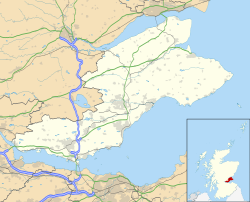56°19′12.43″N 3°0′34.77″W / 56.3201194°N 3.0096583°W
This article has multiple issues. Please help improve it or discuss these issues on the talk page. (Learn how and when to remove these messages)
|
| Cupar Castle | |
|---|---|
| Coordinates | 56°19′12″N 3°00′37″W / 56.32002800°N 3.01029150°W |
Cupar Castle was a royal castle at Cupar, Fife, Scotland. It was located on a small hill or motte that is known as Castle Hill next to Castlehill Primary School in Cupar. No vestiges of the castle remain above ground.
History
editThe castle was built by the Earls of Fife in the 11th century. King Alexander III's wife Margaret died at the castle on 26 February 1275.[1]
The castle traded hands several times during the first and second Scottish War of Independence.
The castle was surrendered to the English in 1296, and King Edward I of England stayed there for a time. In 1306, Scottish forces led by Robert Wishart, Bishop of Glasgow, attacked the English garrison at the castle and besieged it. Wishart was captured by the English at Cupar and imprisoned until he was ransomed after the Scottish victory at the Battle of Bannockburn. In 1308 the Warden of Cupar Castle, Sir Thomas Grey, was ambushed on his way back from Edward II's coronation by a follower of Robert Bruce, Walter de Bickerton.[2] Although heavily outnumbered, Thomas routed Bickerton's men through the use of cavalry charges and by deceiving his enemy that they were greater in number than they really were.[2] However, that same year, Cupar Castle was recovered for the Scots by Robert the Bruce.[3]
The forces of the pretender Edward Balliol retook the castle for the English in 1332. In April 1336 the forces of Robert Stewart, then Guardian of the Realm laid siege to Cupar Castle. The following month English forces, led by John de Strivelyn, relieved the English forces occupying the castle breaking the siege. The castle was surrendered by the English constable Sir William Bullock to William Douglas, Lord of Liddesdale in 1339.[4]
The court of the Stewart of Fife sat at the castle until 1425.
Citations
edit- ^ Ashley (2002), p.492.
- ^ a b Maxwell 1907
- ^ Barrow, Geoffrey W. S. (1988). Robert Bruce and the Community of the Realm of Scotland. Edinburgh, Scotland: Edinburgh University Press. p. 190. ISBN 0-85224-604-8.
- ^ Penman, Michael (2008). David II. East Linton, Scotland: Tuckwell Press Ltd. pp. 57, 66.
References
edit- Ashley, Mike (2002). British Kings & Queens. Carroll & Graf. ISBN 0-7867-1104-3.
- Maxwell, Herbert (1907). Scalacronica; The reigns of Edward I, Edward II and Edward III as Recorded by Sir Thomas Gray. Glasgow: James Maclehose & Sons. Retrieved 17 October 2012.
